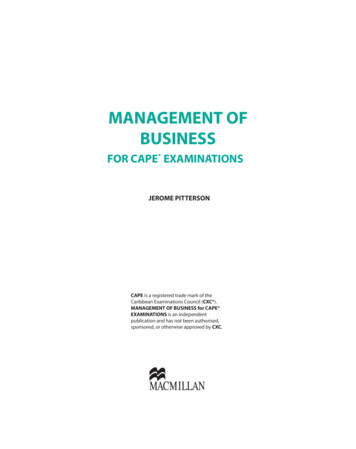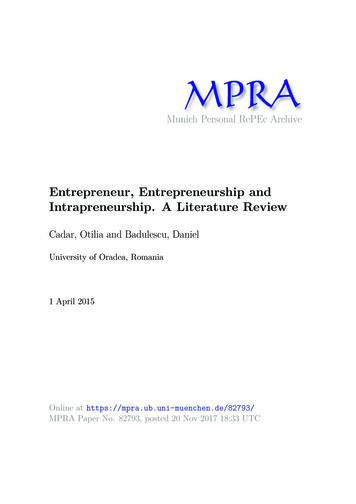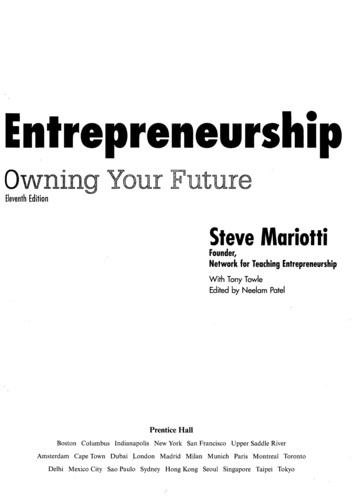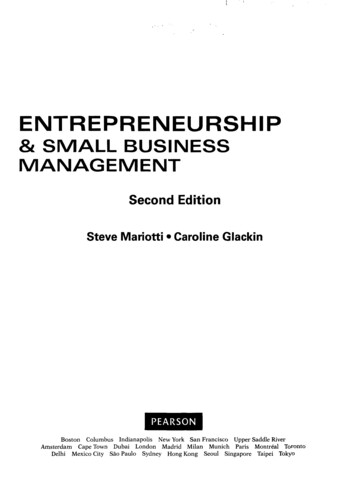
Transcription
HANDBOOK OF RESEARCH INENTREPRENEURSHIP EDUCATION,VOLUME 1
Handbook of Research inEntrepreneurship Education,Volume 1A General PerspectiveEdited byAlain FayolleEM Lyon and CERAG Laboratory, France and Visiting Professor,Solvay Business School, BelgiumEdward ElgarCheltenham, UK Northampton, MA, USA
Alain Fayolle, 2007All rights reserved. No part of this publication may be reproduced, stored in a retrieval system ortransmitted in any form or by any means, electronic, mechanical or photocopying, recording, orotherwise without the prior permission of the publisher.Published byEdward Elgar Publishing LimitedGlensanda HouseMontpellier ParadeCheltenhamGlos GL50 1UAUKEdward Elgar Publishing, Inc.William Pratt House9 Dewey CourtNorthamptonMassachusetts 01060USAA catalogue record for this bookis available from the British LibraryLibrary of Congress Cataloguing in Publication DataHandbook of research in entrepreneurship education/edited by Alain Fayolle.v. cm.Includes bibliographical references and index.Contents: v. 1. A general perspective.1. Entrepreneurship—Study and teaching. 2. Business education.3. Entrepreneurship—Research. I. Fayolle, 1ISBN 978 1 84542 106 9 (cased)Printed and bound in Great Britain by MPG Books Ltd, Bodmin, Cornwall
ContentsList of figuresList of tablesList of contributorsForeword: the third wave of entrepreneurship education and the importance of funin learning by Jerome A. Katz1Cornerstones of change: revisiting and challenging new perspectives onresearch in entrepreneurship educationJill Kickul and Alain FayollePART I23456789xi1CHANGING PARADIGMSChanging the entrepreneurship education paradigmDavid KirbyLearning as an entrepreneurial processDaniel Hjorth and Bengt JohannissonCreating the entrepreneurial university: do we need a wholly differentmodel of entrepreneurship?Allan GibbTeaching entrepreneurship at university: from the wrong building tothe right philosophyKevin HindleThe framework of static and dynamic components: an examinationof entrepreneurial orientation and university ability to teachentrepreneurshipZelimir W. TodorovicPART IIviiviiiix214667104127RENEWING METHODSStrategies for teaching entrepreneurship: what else beyond lectures, casestudies and business plans?Camille CarrierSocial constructionist thinking: some implications for entrepreneurshipresearch and educationDenise FletcherMulti-disciplinary entrepreneurship clinic: experiential education intheory and practicePeter Robinson and Sandra Malachv143160173
viContents10Towards a new methodology to assess the entrepreneurship teachingprogrammesAlain Fayolle, Benoît Gailly and Narjisse Lassas-ClercA conceptual approach to better diagnosis and resolution ofcross-cultural and gender challenges in entrepreneurial researchBonita L. Betters-Reed, Lynda L. Moore and Laurie M. Hunt11PART III1213141516198UNDERSTANDING CONTENTSEntrepreneurial marketing and university educationGerald E. Hills, Claes M. Hultman and Morgan P. MilesThe role of entrepreneurship education in the entrepreneurial processFrancisco LiñánEvaluating entrepreneurship education and training: implications forprogramme designColette Henry, Frances M. Hill and Claire M. LeitchArchetypes of pedagogical innovation for entrepreneurship in highereducation: model and illustrationsJean-Pierre Béchard and Denis GrégoireLearning risk-taking competencesPaula Kyrö and Annukka TapaniIndex187219230248261285311
3.213.313.414.114.2Teaching and learning perspectivesEntrepreneurial life cycle/issuesPedagogical elements in entrepreneurship educationUniversity integration of multiple applications of learningCritical and creative thinkingThe dominant model of the entrepreneur being taught?Towards an appropriate model for entrepreneurial teachingThe pyramid approach to business educationThe wheel template for building an entrepreneurship curriculumConceptual framework of entrepreneurial education at anentrepreneurially oriented universityETP assessment modelThe five factors: from a unilateral to a multidimensional approachThe entrepreneurial processEntrepreneurial intention modelObjectives of entrepreneurship educationRole of entrepreneurship education in the entrepreneurial processMethodology employed for constructing the frameworkA framework for the development of entrepreneurship 236238241255256
.215.315.416.116.216.316.416.516.616.716.816.9The focus of learningValues in the teaching paradigmThe entrepreneurial life worldGuidelines for designing the entrepreneurial organizationThe application of social constructionist ideas in entrepreneurshipresearch and educationSources of cognitive knowledgeSurvey resultsValidation of Azjen’s modelAnalysis of students’ backgroundAnalysis of students’ initial intentionTeaching marketing principles propositions: entrepreneurs’ marketingbehavior and action teaching implicationsAnalytical frameworkConsulted sources to identify innovative entrepreneurship programsin higher educationSource material for each caseFour archetypes of pedagogical innovation in entrepreneurshipeducationReflection formatLevels of learning deduced from the critical theoryThe results of the open coding: three core categories in the learningprocessThe individual risk-taking learning pathsSummary of the sources of confusionSummary of action orientationSummary of learning orientationCombined individual risk learning pathsSummary of the results and coding 9294294295298299299299300302
ContributorsJean-Pierre Béchard, HEC Montréal, CanadaBonita L. Betters-Reed, Simmons School of Management, USCamille Carrier, Université du Québec à Trois-Rivières, CanadaAlain Fayolle, EM Lyon, CERAG (Université de Grenoble), France, Solvay BusinessSchool, BelgiumDenise Fletcher, University of Sheffield Management School, EnglandBenoît Gailly, Université catholique de Louvain, BelgiumAllan Gibb, University of Durham, EnglandDenis Grégoire, J. Mack Robinson College of Business, Georgia State University, USAColette Henry, School of Business and Humanities, Dundalk Institute of Technology,IrelandFrances M. Hill, School of Management and Economics, Queen’s University, Belfast,Northern IrelandGerald E. Hills, University of Illinois at Chicago, USAKevin Hindle, Australian Graduate School of Entrepreneurship, AustraliaDaniel Hjorth, Copenhagen Business School, DenmarkClaes M. Hultman, Faculty of Business, Orebro University, SwedenLaurie M. Hunt, Simmons School of Management, USABengt Johannisson, Växjö University, SwedenJerome A. Katz, John Cook School of Business, Saint Louis University, USAJill Kickul, Forsythe Chair in Entrepreneurship, Thomas C. Page Center forEntrepreneurship, Richard T. Farmer School of Business, Miami University, USADavid Kirby, School of Management, University of Surrey, EnglandPaula Kyrö, University of Tampere, FinlandNarjisse Lassas-Clerc, EM Lyon, FranceClaire M. Leitch, School of Management and Economics, Queen’s University, Belfast,Northern IrelandFrancisco Liñán, University of Seville, Spainix
xContributorsSandra Malach, University of Calgary, CanadaMorgan P. Miles, Georgia Southern University, USALynda L. Moore, Simmons School of Management, USAPeter Robinson, Utah Valley State College, USAAnnukka Tapani, University of Tampere, FinlandZelimir W. Todorovic, Indiana Purdue University, USA
Foreword: the third wave of entrepreneurshipeducation and the importance of fun in learningJerome A. KatzIn my 2006 United States Association for Small Business and Entrepreneurship (USASBE)keynote address (Katz, 2006a), I made the point that the business-school based disciplineof entrepreneurship was arguably the point of centrality for the new wave of growth inentrepreneurship education – a wave which is spreading out from business schools acrosscampuses. The first wave of entrepreneurship education was a global one, spread by agricultural researchers through the model we have come to know as agricultural extension(Jones and Garforth, 1997; Katz, 2006b). The second wave came when the extension modelwas embraced by business school faculty and government business development specialists,and the business-school based approach to entrepreneurship education emerged, spreadingacross the United States, and then to business schools worldwide (Katz, 2006b).Today, with business schools as the center or hub, we are seeing the third wave ofgrowth, which is across individual campuses rather than jumping from one university toanother. Called cross-campus entrepreneurship (Fountain, 2004; Shaver, 2005) or academic entrepreneurship (Shane, 2004), we see a renewed growth (cf. Vesper, 1985) across disciplines, and this volume showcases the nature and benefits of that third wave.Part of this growth comes from the creation of new forms of entrepreneurship and academic programs to teach it. Part I of this volume focuses on this process. For example, intheir chapters, David Kirby, Allan Gibb, Kevin Hindle, and Zelimir Todorovic conceptualize what forms that broader and more inclusive model of entrepreneurship might take.Why are new models needed? In part because of the burden of the intellectual legacy ofbusiness schools, with their fixation on the managerial (versus the entrepreneurial) model,which is wonderfully described in the chapter of Hjorth and Johannisson. It is also causedin part by the social legacy of business schools, with their fixation on perpetuating historical networks, networks which excluded women and minorities, a problem outlined andchallenged in the chapter by Betters-Reed, Moore and Hunt in Part II. The potential forredefining the nature of entrepreneurship and entrepreneurship education comes from thepower of groups to socially construct their realities. In her chapter in Part II, DeniseFletcher points out how moving away from the social constructivist model typical ofbusiness-school-based entrepreneurship education and toward a social constructionistapproach could offer enhanced intellectual freedom to academics in search of a more realistic and inclusive paradigm.This theme of a new paradigm of entrepreneurship education gets carried over intoPart II of this volume. Part of maturity of a field is seen when there is general agreementon content, with continuing discussions on process. Through the lens of the new paradigm, even the traditional content becomes the subject of reflection and revision. Perhapsthe sine qua non of the contemporary business-school approach to entrepreneurship isthe business plan. Camille Carrier challenges the wisdom of propagating this model asxi
xiiForewordentrepreneurship evolves in business schools and beyond, and champions alternative pedagogies in her chapter.While small-business advising and consulting was pioneered by the agricultural extensionists of the nineteenth century (Katz, 2006b), it remains a mainstay of the businessschool approach, and as such is ripe for a reconsideration. The Robinson and Malachchapter provides an opportunity to observe the operationalization of one such broaderapproach, in the specific form of a multi-disciplinary entrepreneurship clinic. The agricultural extension heritage included evaluation as an essential element in the process ofimprovement, and that focus on outcomes has continued in the business school and seemsto have made the move to the new paradigm of cross-campus entrepreneurship education.The chapter by Fayolle, Gailly and Lassas-Clerc in Part II describes one such effort atfresh thinking for evaluating a business-school program. It is complemented by a pair ofstudies in Part III that articulate and operationalize evaluative approaches based on thenew paradigm of entrepreneurship education. Béchard and Grégoire use the idea of internal coherence to compare four widely different business programs, while Henry, Hill andLeitch use a more conventional approach to evaluate entrepreneurial training programs.As noted, Part III complements the evaluative concept introduced in Part II of thisvolume, but also includes distinctive material on the specific content of entrepreneurshipeducation. Hills, Hultman and Miles offer a review of the work and concepts which underlie a marketing approach to entrepreneurship. While unquestionably a part of the business school approach, marketing has historically taken a secondary position tomanagement as a contributor and supporter of business-school entrepreneurship education. As the less-heard voice of the business-school based discipline (following the argument of Betters-Reed, Moore and Hunt in this volume), it is important to give attentionto the contributions and alternatives offered in this unique chapter.The remaining two chapters in Part III actually complement the ideas in Part I, in effectsuggesting how to operationalize the kinds of thinking necessary to move away from theold paradigms of business-based, managerially driven, entrepreneurship education andto embrace a more distinctive, inclusive and realistic model. Francisco Liñán talks abouthow to increase the supply of entrepreneurially minded individuals in the university, aswell as how these supply-enhancement efforts might be supported educationally. PaulaKyrö and Annukka Tapani approach the idea of increasing entrepreneurialism, but do sofrom the standpoint of teaching people how better to handle insecurity and manage risk.In this first edition of the Handbook of Research in Entrepreneurship Education there isconsiderable promise, but it is promise which carries a measure of irony. Despite the promotion of a new paradigm, and efforts to ask tough questions which are intended to challenge basic assumptions, like Hindle’s ‘Can entrepreneurship be taught?’ this is a volumeof works by educators, individuals steeped in a profession whose fundamental tenet is positivist. If we could not make a difference in other people or institutions by our teaching,why would we do this work?A generation ago, Argyris and Schon (1974; 1978) demonstrated the difficulty of conducting what they called ‘double-loop learning’, learning which starts by challenging thefundamental beliefs and culture of an organization or profession. Argyris, ever the cynicand protagonist himself, admitted that double-loop learning was extraordinarily difficultto achieve, and often comes in momentary insights, not sustained bursts. He also admitted that being challenged by those from outside the dominant culture helped double-loop
Forewordxiiilearning – the fable of the ‘emperor’s new clothes’ often was mentioned in his classes asthe metaphor.The contributors here are making efforts to achieve the insights and benefits of doubleloop learning, and we can clearly see the benefits of their moments of double-loop learning insights. But it is also clear that there is still far to go. Consider, as you look at thebiographical statements of the contributors, how many are based in business schools. Ifthey can remain true to the dream of the new paradigm, contributions to the next editionof the Handbook will show a greater diversity of contributors and, with that, a greaterchance of sustaining those moments of a double-loop learning perspective.Those of you familiar with my work know that it is not characteristic of me to end ona note of negativism or even irony, and this Foreword is no exception. In these final wordsI want to draw your attention to a concept which recurs in a few of the chapters in thisvolume of the Handbook, which while by no means a common theme, is of great importance. It is the idea of fun in entrepreneurship.Part of what this volume helped me recognize was the importance of fun. It is a subjectI studied many years ago (Katz, 1987), and while I try to practice it in my teaching andwork, I had not thought about it for years until reading this volume. Hindle infuses entrepreneurship education with Whitehead’s vocational transcendence – the philosopher’spolysyllabic expression for ‘fun at work’, and Allan Gibb talks about how entrepreneurship might be a way to help people draw enjoyment from an increasingly complex anduncertain world. When two thinkers of entrepreneurship who are from different generations and opposite corners of the world start talking about the same idea at the same time,I personally sit up and take notice. When we add to this how William Gartner imploresour field to celebrate each other’s contributions (Gartner, 2001), and the contributions ofthe entrepreneurs themselves (Carter et al., 2002), it brings me to the realization that funshould be a part of our approach to these other potential contributors to entrepreneurship across the campus.Could fun have any practical value in the creation of a discipline or the process of educating individuals in it? The answer seems obvious – at least on the educating side.Students of all ages are attracted by the fun of a field, and that fun is part of whatstrengthens them to persevere when times are tough and not fun (Katz, 1987). How manystudents are attracted to chemistry by the initial chance to make something explode, burnor smell? It is fun like that which attracts and energizes young chemists to survive yearsof educational tedium. For those building a new discipline, often in institutionally hostileterritory, the moments of fun may become all the more important as a way to sustaineffort over the coming years.In the old paradigm, with increasing numbers of courses in entrepreneurship majors,and high levels of consistency in what topics are taught and what techniques are used toteach, the potential for tedium in our own discipline increases. Professional schoolspromote professionalism, which seems to take a cultural position antithetical to theconcept of fun. That is why MDs like ‘Patch’ Adams (who was portrayed on the screenby Robin Williams), get ostracized and remain the exception and not the rule in our professions (Adams and Mylander, 1993). Perhaps we need to make sure that part of the newparadigm of entrepreneurship education includes ‘having fun’ as one of its desiderata.Can entrepreneurship education be fun? Arguably, our professional gatherings appearto be more fun than those of many other professions. Think of how many newcomers you
xivForewordhave met at some convention of entrepreneurship educators who remarked how friendlythese educators were, or how much fun they seemed to have together. Part of this comesfrom the current dominant culture of the discipline, which is more interested in sharingideas than claiming them, which is benefiting from a time when entrepreneurship education (and the resources and students devoted to it) are growing rapidly, and which isperhaps inspired by the fun that the entrepreneurs we study encourage in themselves, theirfirms and, by extension, us.Seeing a professor who recognizes and knows how to capture and share the fun andbeauty of their discipline becomes a reminder to us all of what education at its best is allabout. Watching a classic lecture by physicist Richard Feynman or hearing Guy Kawasaki(2004) talk about the fun inherent in recognizing The Art of the Start reminds us all of theawesome power of beauty and fun in our lives and in our teaching.1It is a rare world which would have too much fun, and we are centuries from discovering one in the cosmos or creating one on this earth. However, we absolutely have thepotential, the ability and (through efforts like this volume and the work you do every day)the material to bring moments of fun before our students, colleagues, and communities.Although we do not spend enough time or thought considering fun, whenever you canoffer it to others, you make them, and our discipline, stronger.So, welcome to the first volume of the first edition of the Handbook of Research inEntrepreneurship Education. Please remember to have some fun while you visit, and feelfree to use the closing quote – after all, it was published in a respected handbook:Done right, entrepreneurship should be fun, and done right, so should entrepreneurship education. (Jerome Katz)Note1. Those interested in videos showing Richard Feynman in action can find his filmography at www.imdb.com/name/nm0275509/, and can see some of his lectures online at www.vega.org.uk/video/subseries/8. Thoseinterested in Guy Kawasaki’s presentations can go to http://edcorner.stanford.edu/AdvSearchServe3?x 32&y 11&openkeyword &authors 24&eterms.ReferencesAdams, P. and Mylander, M. (1993), Gesundheit: Good Health Is a Laughing Matter, Rochester, VT: HealingArts Press.Argyris, C. and Schon, D.A. (1974), Theory in Practice: Increasing Professional Effectiveness, San Francisco,CA: Jossey-Bass.Argyris, C. and Schon, D.A. (1978), Organizational Learning: A Theory of Action Perspective, San Francisco,CA: Jossey-Bass.Carter, N.M., Gartner, W.B., Greene, P.G., Cox, L.W. and Reynolds, P.D. (2002), The Entrepreneur Next Door:Characteristics of Individuals Starting Companies in America, Kansas City, MO: Kauffman Foundation.Fountain, M.W. (2004), ‘The development and implementation of an inter-disciplinary graduate course linkingengineering, medical, and business students with university research investigators to develop strategies tocommercialize new technologies’, ASEE Annual Conference and Exposition: Engineering Education ReachesNew Heights, Salt Lake City, UT; USA, 20–23 June, ticle 1016&context eci/teaching.Gartner, W.B. (2001), ‘Is there an elephant in entrepreneurship? Blind assumptions in theory development’,Entrepreneurship Theory and Practice, 25 (4), 27–40.Jones, G.E. and Garforth, C. (1997), ‘The history, development, and future of agricultural extension’, in B.E.Swanson, R.P. Bentz and A.J. Sofranko (eds), Improving Agricultural Extension. A Reference Manual, Rome:Food and Agriculture Organization of the United Nations, ch. 1, ure%20of%20agricultural%20extension.
ForewordxvKatz, J.A. (1987), ‘Playing at innovation in the computer revolution’, in M. Frese, E. Ulich and W. Dzida (eds),Psychological Issues of Human–Computer Interaction in the Work Place, Amsterdam: North-Holland,pp. 97–111.Katz, J.A. (2006a), ‘And another thing’ (the 2006 Coleman Foundation White Paper on entrepreneurship), USAssociation for Small Business and Entrepreneurship, -Final.pdf.Katz, J.A. (2006b), ‘Education and training in entrepreneurship’, in J.R. Baum, M. Frese and R.A. Baron (eds),The Psychology of Entrepreneurship, Mahwah, NJ: Lawrence Erlbaum Associates.Kawasaki, G. (2004), The Art of the Start, New York: Portfolio.Shane, S.A. (2004), Academic Entrepreneurship: University Spinoffs and Wealth Creation, Cheltenham, UK andNorthampton, MA, USA: Edward Elgar.Shaver, K.G. (2005), ‘Reflections on a new academic path: entrepreneurship in the arts and sciences’, PeerReview, Spring, www.findarticles.com/p/articles/mi qa4115/is 200504/ai n14718124.Vesper, K.H. (1985), Entrepreneurship Education – 1985, Babson, MA: Babson College Center for EntrepreneurialStudies.
1Cornerstones of change: revisiting andchallenging new perspectives on researchin entrepreneurship educationJill Kickul and Alain FayolleEntrepreneurial organizations have undergone substantial changes and transformationsduring the last two decades in order to compete successfully on a global scale. Sustainingrevenue growth and increasing shareholder value as well as adding value to products/services have become the key ingredients in defining organizational success. In order to achievemany of these goals, the entrepreneurs of these companies must find creative and innovative ways to increase levels of efficiency, lower costs, and improve processes throughout theentire organization. In addition, these entrepreneurs must also be able to formulate strategies that are flexible to allow for continual redesign and reconfiguration of the organization as it grows and matures (Hitt, 1998; Teece and Pisano, 1994; Teece et al., 1997).With all these changes and demands on an entrepreneur’s skills and abilities, entrepreneurship educators must find alternative and non-traditional methods of teaching entrepreneurship. Entrepreneurship educators need to be more proactive and innovative inhow they plan and organize their programs to develop entrepreneurs. That is, educatorsneed to be more responsive to the changing conditions of the marketplace in order todevelop future entrepreneurs. Moreover, they also need to teach students in the field concepts and skills that can be directly applied toward starting, managing, and growing anenterprise. Skills that require nonlinear learning and thinking (Hitt et al., 1998; Kerr andJackofsky, 1989) may become critical to the survival of their business. In addition, a diversity of knowledge in finance/cash management, accounting, strategic thinking, and entrepreneurial leadership are often the most cited requisite areas of development forsuccessful entrepreneurship (Hood and Young, 1993).The focus of this introductory chapter is to demonstrate how universities and educators teaching entrepreneurship can take a multidisciplinary approach in how they designand implement their curriculum. Rather than increasing the number of courses offered ina program, this approach advocates for an integrative approach that capitalizes on allfacets of entrepreneurship. The challenge in designing the curriculum would not be toincrease the breadth of offerings, but rather to increase the quality of offerings so that thefocus incorporates all areas of the entrepreneurial experience from start-up to growth andmaturity. Students should not only learn about the skills involved in the operational sideof managing a new venture (for example, accounting, finance, marketing, team communications) but also begin to comprehend how the interrelationships of these skill areas areinherent in complex business problems. Moreover, by adopting an interdisciplinary perspective, students would be better able to understand issues that are relevant to managinga venture as it moves through different stages within the entrepreneurial life-cycle.In addition, this introductory chapter introduces pedagogical elements of how entrepreneurship can be taught in order to facilitate and enhance the knowledge and abilities of1
2Handbook of research in entrepreneurship educationfuture business owners. Instead of relying on formal didactic methods to teach entrepreneurship, other approaches that allow for learning under conditions of ambiguity anduncertainty are recommended. Additional programs that universities could implementwithin the structure and framework of their curriculum are also discussed. These supportprograms include establishing an incubator program together with an intensive mentoringprogram. Furthermore, setting up special venture capital funds for students and alumni aswell as developing student consulting groups that allow the students to learn about theintricacies and complexities of managing a growing organization should also be considered. Finally, given the focus of the Handbook, we comment on how, along with the following chapters, we can make recommendations based on providing future research.Redesigning the entrepreneurship curriculum: the path towards learningDue to the changing economic landscape, entrepreneurship educators need to be moreflexible and demonstrate a willingness to alter their plans in order to meet the diverse andgrowing needs of our students. In many cases, educators need to assist future entrepreneurs in the learning process by making them recognize multiple opportunities for learning and develop the necessary skills and abilities to become more effective at self-direction.The way in which entrepreneurship educators’ design their curriculums can be based onmany of the same elements found within learning organizations. In these types of organizations, employees are free to think for themselves, to identify multiple problems andopportunities, and to have the ability to take measures for the complete implementationof those opportunities (Aubrey and Cohen, 1995).Thus, one particular way to redesign an entrepreneurship curriculum is to shift from ateaching perspective to a learning perspective (see Figure 1.1). A focus on teaching incorporates an input orientation where students only concentrate on narrowly defined, specialized content and knowledge. Most of the curriculum is organized around specific disciplinesthat compliment the departments within a business school. This specialized-based approachto curriculum design mirrors the faculty’s framework for knowledge and not essentially thestudent’s. Faculty also control the input and make the determination on what type of material is necessary to teach the students. Attention within the teaching perspective is placed primarily on faculty members and individuals with their respective specialized fields, withminimal integration among the different areas of knowledge (Boyatzis et al., 1995).Conversely, the learning perspective focuses on an output orientation where bothcontent and process are examined to achieve the desired output. In this perspective, educators take an active role in gauging a student’s learning progress. ‘An output orientationalso requires discovery and determination of what a student is learning’ (Boyatzis et al.,1995, p. 9). The learning perspective shifts the responsibility of organizing knowledgeonto the student. It focuses more on problem-centered or contextually defined knowledgeas opposed to disciplined-defined knowledge. The rate and flow of understanding are concentrated around the student’s own competencies, not necessarily the faculty’s orientation. By taking a learning perspective, un
Handbook of research in entrepreneurship education/edited by Alain Fayolle. v. cm. Includes bibliographical references and index. Contents: v. 1. A general perspective. 1. Entrepreneurship—Study and teaching. 2. Business education. 3. Entrepreneurship—Research. I. Fayolle, Alain. HB










